Top Rankings
Tracy Area Public School District ranks among the top 20% of public school district in Minnesota for:
Category
Attribute
Overall Rank
Highest overall rank (Top 20%)
Reading/Language Arts Proficiency
Highest reading/language arts proficiency (Top 20%)
Science Proficiency
Highest science proficiency (Top 5%)
Graduation Rate
Highest graduation rate (Top 20%)
For the 2025 school year, there are 3 public schools serving 688 students in Tracy Area Public School District. This district's average testing ranking is 9/10, which is in the top 20% of public schools in Minnesota.
Public Schools in Tracy Area Public School District have an average math proficiency score of 51% (versus the Minnesota public school average of 45%), and reading proficiency score of 57% (versus the 51% statewide average).
Minority enrollment is 27% of the student body (majority Asian), which is less than the Minnesota public school average of 39% (majority Black and Hispanic).
Overview
This School District
This State (MN)
# Schools
3 Schools
2,732 Schools
# Students
688 Students
870,790 Students
# Teachers
52 Teachers
57,779 Teachers
Student : Teacher Ratio
13:1
13:1
District Rank
Tracy Area Public School District, which is ranked within the top 20% of all 522 school districts in Minnesota (based off of combined math and reading proficiency testing data) for the 2021-2022 school year.
The school district's graduation rate of 90-94% has increased from 90% over five school years.
Overall District Rank
#92 out of 527 school districts
(Top 20%)
(Top 20%)

Math Test Scores (% Proficient)
51%
45%
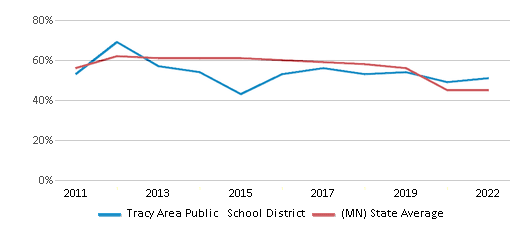
Reading/Language Arts Test Scores (% Proficient)
57%
51%
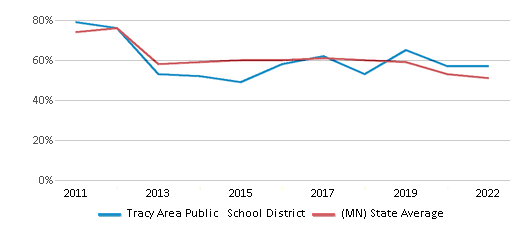
Science Test Scores (% Proficient)
59%
41%

Graduation Rate
90-94%
84%
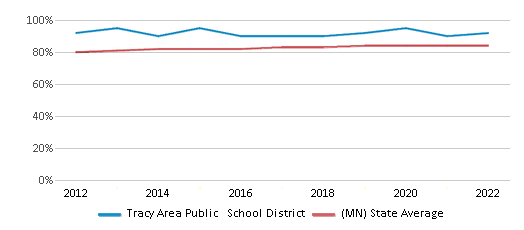
Students by Ethnicity:
Diversity Score
0.44
0.59
# American Indian Students
4 Students
15,699 Students
% American Indian Students
1%
2%
# Asian Students
97 Students
61,819 Students
% Asian Students
14%
7%
# Hispanic Students
62 Students
99,588 Students
% Hispanic Students
9%
12%
# Black Students
5 Students
102,736 Students
% Black Students
1%
12%
# White Students
505 Students
534,612 Students
% White Students
73%
61%
# Hawaiian Students
n/a
1,007 Students
% Hawaiian Students
n/a
n/a
# Two or more races Students
15 Students
55,329 Students
% of Two or more races Students
2%
6%
Students by Grade:
# Students in PK Grade:
25
24,648
# Students in K Grade:
53
59,654
# Students in 1st Grade:
44
61,859
# Students in 2nd Grade:
44
63,560
# Students in 3rd Grade:
43
61,751
# Students in 4th Grade:
49
63,575
# Students in 5th Grade:
54
63,290
# Students in 6th Grade:
41
63,180
# Students in 7th Grade:
61
63,243
# Students in 8th Grade:
59
64,723
# Students in 9th Grade:
56
67,716
# Students in 10th Grade:
45
69,634
# Students in 11th Grade:
64
69,942
# Students in 12th Grade:
50
74,015
# Ungraded Students:
-
-
District Revenue and Spending
The revenue/student of $16,093 in this school district is less than the state median of $17,854. The school district revenue/student has stayed relatively flat over four school years.
The school district's spending/student of $15,911 is less than the state median of $18,580. The school district spending/student has stayed relatively flat over four school years.
Total Revenue
$11 MM
$15,547 MM
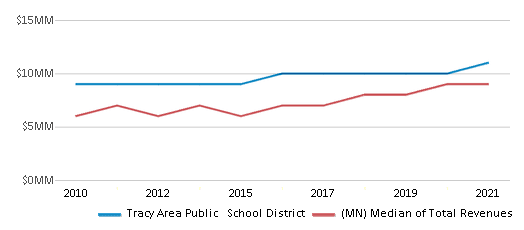
Spending
$11 MM
$16,179 MM

Revenue / Student
$16,093
$17,854
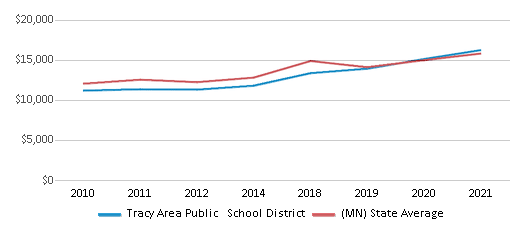
Spending / Student
$15,911
$18,580
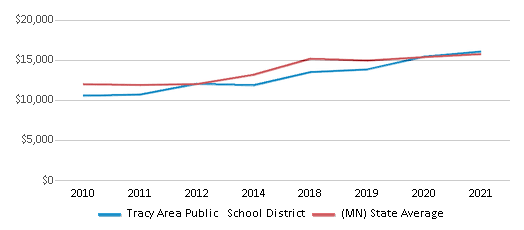
Best Tracy Area Public School District Public Schools (2025)
School
(Math and Reading Proficiency)
(Math and Reading Proficiency)
Location
Grades
Students
Rank: #11.
Tracy Elementary School
(Math: 60-64% | Reading: 55-59%)
Rank:
Rank:
9/
Top 20%10
700 S 4th St
Tracy, MN 56175
(507) 629-5518
Tracy, MN 56175
(507) 629-5518
Grades: PK-6
| 353 students
Rank: #22.
Tracy Secondary
(Math: 35-39% | Reading: 55-59%)
Rank:
Rank:
6/
Top 50%10
934 Pine St
Tracy, MN 56175
(507) 629-5500
Tracy, MN 56175
(507) 629-5500
Grades: 7-12
| 334 students
Rank: n/an/a
Out-of-state Care And Treatment
Alternative School
934 Pine St
Tracy, MN 56175
(507) 629-5500
Tracy, MN 56175
(507) 629-5500
Grades: K-12
| 1 students
Frequently Asked Questions
How many schools belong to Tracy Area Public School District?
Tracy Area Public School District manages 3 public schools serving 688 students.
What is the rank of Tracy Area Public School District?
Tracy Area Public School District is ranked #95 out of 522 school districts in Minnesota (top 20%) based off of combined math and reading proficiency testing data for the 2021-2022 school year. This district ranks in the top 20% of Minnesota school districts for: Highest overall rank (Top 20%), Highest reading/language arts proficiency (Top 20%), Highest science proficiency (Top 5%) and Highest graduation rate (Top 20%)
What is the racial composition of students in Tracy Area Public School District?
73% of Tracy Area Public School District students are White, 14% of students are Asian, 9% of students are Hispanic, 2% of students are Two or more races, 1% of students are American Indian, and 1% of students are Black.
What is the student/teacher ratio of Tracy Area Public School District?
Tracy Area Public School District has a student/teacher ratio of 13:1, which is lower than the Minnesota state average of 15:1.
What is Tracy Area Public School District's spending/student ratio?
The school district's spending/student of $15,911 is less than the state median of $18,580. The school district spending/student has stayed relatively flat over four school years.
Recent Articles

Year-Round Or Traditional Schedule?
Which is more appropriate for your child? A year-round attendance schedule or traditional schedule? We look at the pros and cons.

Why You Should Encourage Your Child to Join a Sports Team
Participating in team sports has a great many benefits for children, there is no doubt. In this article you will learn what those benefits are.

White Students are Now the Minority in U.S. Public Schools
Increasing birth rates among immigrant families from Asia and Central and South America, combined with lower birth rates among white families, means that for the first time in history, public school students in the United States are majority-minority. This shift in demographics poses difficulties for schools as they work to accommodate children of varying language abilities and socio-economic backgrounds.





